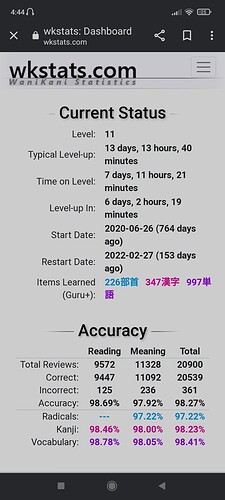Here I am. After my total reset. Back into the depths of kanji hell. The pain truly never ends.
Anyways, after that dramatic opening, I’m finally past level 10! I made it to level 11 a couple of days ago which means I’m finally in the painful levels, again. I don’t really remember these levels being all too bad, most certainly not as bad as the death levels.
I’ve gone at a relatively similar pace as I went during my first attempt at wanikani, but now I can finally understand some kanji better, and recognise them much quicker than I initially could. Also, a bit embarrassing considering I spent a year on my first run, but I finally found out what the hell the difference is between a transative and intransitive verb. So that’s helped quite a lot when it comes to some grammar.
Speaking of grammar, I’ve finally prioritised it after so so long, and I can finally understand why people enjoy this more than learning 2000 kanji! You can definitely see yourself improve more and more with grammar than you can with kanji, but that’s a topic for my two years on WaniKani post.
Other than that, since my last post, not much has changed regarding how I study. Oh I did actually recently get a genkouyoushi notebook to practice my handwriting but damn it is so difficult. Tips would be greatly appreciated!
My accuracy has still stayed very consistent and hasn’t dropped too much yet, but I’ll have to inform you after I reach the death levels and the pain truly sets in!
I guess I’d describe the painful levels as a kind of pleasurable pain where you can slow down and back out for a little bit if you want to, but man the death levels are just. Well. Death.
I guess that’s really it for this post! Not much to report on but I’ll be back at the end of August to give a detailed update about the treacherous Japanese journey I’ve been through these past 12 months. Until then, さよなら, or I guess
じゃね, since I won’t be gone that long!
